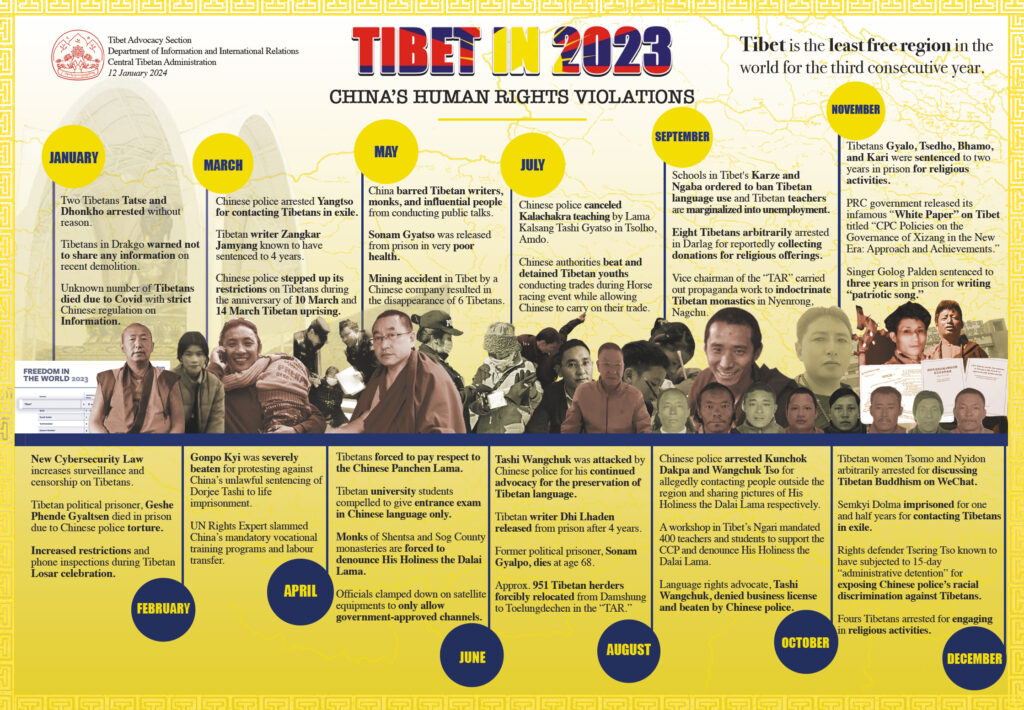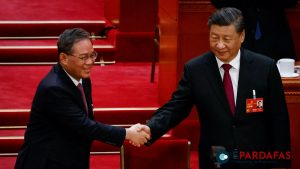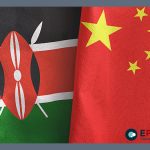
Year of Injustice: The Disturbing Chronicle of China’s Actions in Tibet in 2023
The unfolding of the year 2023 witnessed a tragic saga of systematic human rights abuses in Tibet, where the People’s Republic of China (PRC) persisted in its relentless assault on the Tibetan people. This extensive exposé delves deep into the multifaceted dimensions of China’s transgressions, chronicling the persistent persecution of Tibetans against the backdrop of a global movement determined to expose and confront China’s egregious actions. This elongated article aims to illuminate the intricate tapestry of China’s violations in Tibet, intensifying the call for a unified international response to rectify these gross injustices.
China’s Human Rights Violations in Tibet: A Monthly Chronicle
January: Arrests and Silence
The year began with the unjust arrest of two Tibetans, Tatse and Dhonkho, for reasons unknown. Meanwhile, Tibetans in Drakgo were warned against sharing information on recent demolitions. The strict Chinese regulations on information also contributed to the loss of an unknown number of Tibetan lives due to COVID-19.
February: Tightening Grip
China escalated its control with a new Cybersecurity Law, increasing surveillance and censorship on Tibetans. The tragic death of Tibetan political prisoner Geshe Phende Gyaltsen, tortured to death in a Chinese prison, served as a chilling testament to the brutalities within. The Tibetan Losar celebration was marred by intensified restrictions and intrusive phone inspections, extinguishing any semblance of cultural autonomy.
March: Crackdown on Dissent
China’s assault on Tibetan voices reached new heights, as Yangtso was apprehended for daring to contact Tibetans in exile. The imprisonment of Zangkar Jamyang, a Tibetan writer, for four years underscored the authoritarian clampdown on freedom of expression. The anniversaries of the 10th and 14th March Tibetan uprisings became grim reminders of Chinese oppression, with heightened restrictions on Tibetan communities.
April: Protests and International Critique
The tyrannical narrative continued as Gonpo Kyi faced brutal beatings for protesting China’s unjust sentencing of Dorjee Tashi to life imprisonment. International condemnation echoed when a UN Rights Expert decried China’s mandatory vocational training programs and labor transfers, mechanisms perpetuating systemic abuse.
May: Cultural Suppression
China’s assault on intellectual and cultural autonomy escalated as Tibetan writers, monks, and influential figures were barred from engaging in public discourse. The release of Sonam Gyatso from prison, frail and in poor health, epitomized the physical toll of Chinese incarceration. The dark shadow of tragedy loomed over Tibet with a mining accident orchestrated by a Chinese company, leading to the disappearance of six Tibetans.
June: Forced Compliance
The cultural subjugation of Tibetans reached new depths as they were coerced into paying homage to the Chinese-appointed Panchen Lama, eroding religious freedom. Tibetan university students faced linguistic discrimination, compelled to take entrance exams solely in Chinese. The sanctity of monasteries was violated as monks of Shentsa and Sog County were forced to denounce His Holiness the Dalai Lama, highlighting China’s relentless assault on Tibetan spirituality. The authoritarian regime tightened its grip on information flow by clamping down on satellite equipment, limiting access to government-approved channels.
July: Suppression of Cultural Events
China’s contempt for Tibetan religious practices manifested as Chinese authorities canceled the Kalachakra teaching by Lama Kalsang Tashi Gyatso in Tsolho, Amdo. Tibetan youths conducting trades during a horse racing event faced arbitrary beatings and detentions, while their Chinese counterparts faced no such restraints.
August: Targeting Advocates
Tashi Wangchuk, a champion of Tibetan language preservation, fell victim to Chinese police aggression, further illustrating the relentless assault on cultural identity. The release of Tibetan writer Dhi Lhaden from prison after four years served as a rare glimmer of hope amidst a landscape marred by oppression. The demise of former political prisoner Sonam Gyalpo, at age 68, underscored the long-lasting physical and psychological toll of Chinese incarceration. Approximately 951 Tibetan herders were forcibly relocated from Damshung to Toelungdechen in the “TAR,” a sinister move reminiscent of forced demographic shifts.
September: Suppression in Education
China’s assault on Tibetan education intensified, as schools in Tibet’s Karze and Ngaba were ordered to ban the use of the Tibetan language, marginalizing Tibetan teachers. The arbitrary arrest of eight Tibetans in Darlag, accused of collecting donations for religious offerings, exemplified the oppressive measures imposed on religious practices. The vice chairman of the “TAR” spearheaded propaganda to indoctrinate Tibetan monastics in Nyenrong, Nagchu.
October: Further Arrests and Repression
The long arm of Chinese oppression extended with the arrests of Kunchok Dakpa and Wangchuk Tso, accused of contacting people outside the region and sharing images of His Holiness the Dalai Lama, respectively. A workshop in Tibet’s Ngari mandated 400 teachers and students to support the Chinese Communist Party (CCP) while denouncing His Holiness the Dalai Lama. Tashi Wangchuk, an advocate for language rights, was denied a business license and subjected to a beating by Chinese police.
November: Religious Persecution
The year drew to a close with the sentencing of Tibetans Gyalo, Tsedho, Bhamo, and Kari to two years in prison for their religious activities. The PRC government released its notorious “White Paper” on Tibet, a propaganda piece titled “CPC Policies on the Governance of Xizang in the New Era: Approach and Achievements.” Tibetan singer Golog Palden received a three-year prison sentence for composing a “patriotic song.”
December: Arbitrary Arrests Persist
The relentless persecution persisted into December with the arbitrary arrests of Tibetan women Tsomo and Nyidon, accused of discussing Tibetan Buddhism on WeChat. Semkyi Dolma faced imprisonment for one and a half years for contacting Tibetans in exile. Rights defender Tsering Tso endured a 15-day “administrative detention” for exposing Chinese police’s racial discrimination against Tibetans. Four Tibetans were arrested for engaging in religious activities, a grim conclusion to a year marked by widespread human rights violations.

Tibet in 2023: A Mosaic of Despair Under China’s Authoritarian Rule
As the curtains fall on 2023, Tibet stands as a testament to the heinous human rights violations perpetuated by the Chinese government. The systematic erosion of Tibetan identity, culture, and basic freedoms forms a chilling narrative, echoing across the mountains and plains of the region. China’s oppressive tactics, from draconian laws to arbitrary arrests, underscore a relentless pursuit to snuff out the Tibetan spirit.
The international community, while witnessing this relentless onslaught, must rise to the occasion with unwavering determination. The time is now for nations, organizations, and individuals to set aside geopolitical considerations and stand united against the dark forces of injustice. The echoes of Tibet’s plight demand a resounding global response, condemning China’s actions and advocating for the restoration of Tibetan rights and freedoms.
Global Outcry and the Path Forward
Amidst the gloom, a ray of hope emerges from the international community’s growing support for Tibet. Legislative actions, resolutions, statements, and reports condemning the PRC government’s repressive policies signify a collective stand against the erasure of Tibetan identity. This global outcry not only provides a platform for advocacy but also intensifies diplomatic pressure, fostering a deeper understanding of Tibetan issues.
Likewise, the indomitable spirit of the Tibetan people inside Tibet serves as an inspiration to the world. Despite escalating pressure and repression, they remain committed to preserving their identity and resisting the forced Sinicization imposed by the Chinese government. Their resilience calls for solidarity from the global community, urging nations to move beyond rhetoric and take concrete actions against China’s human rights abuses.
China’s Disinformation Machinery: Unveiling the Deception
Amidst the cacophony of China’s disinformation machinery, a stark reality prevails. The “White Paper” on Tibet, titled “CPC Policies on the Governance of Xizang in the New Era: Approach and Achievements,” strategically misinforms the international community. By replacing “Tibet” with “Xizang,” the Chinese government attempts to legitimize its illegal occupation and divert attention from the injustices perpetrated against the Tibetan people. The international community must see through this deceptive narrative, recognizing the true nature of China’s actions in Tibet.
The Role of Advanced AI Tools and Global Repression
China’s utilization of advanced AI tools for monitoring and surveilling Tibetans amplifies the deteriorating human rights conditions. The Tibet Autonomous Region (TAR) Cyber Security Management Regulations, in effect from February 1, 2023, subject individuals engaged in Tibetan cultural, language, or religious activities to stricter regulations and harsher punishments. The lack of specificity in the law grants arbitrary power to Chinese police, enabling them to target Tibetans for cultural, social, and religious conversations. These regulations have disrupted normal Tibetan lives, impeding their ability to practice their culture and express their religious beliefs.
Transnational Repression and the Struggle for Freedom
Transnational repression by the PRC government has induced self-censorship among the Tibetan diaspora. Living in constant fear, Tibetans abroad are forced to sever contact with family members inside Tibet to shield them from potential reprisals by the Chinese government. Credible reports indicate that Tibetan youth have been denied opportunities for government jobs if their family members reside in diaspora communities or are actively involved in exposing China’s repression of Tibet. This coercive tactic compels Tibetans to sever ties with their families abroad, illustrating the far-reaching consequences of China’s repressive policies.
Conclusion: A Call to Confront Injustice
As the grim chronicle of 2023 in Tibet unfolds, it serves as an urgent call to the global community to confront the egregious injustices perpetrated by the Chinese government. The year has witnessed a relentless assault on the fundamental rights and freedoms of the Tibetan people, with China’s authoritarian regime leaving no stone unturned in its quest to suppress Tibetan identity, culture, and autonomy.
The systematic violations documented month by month underscore the urgent need for a unified and resolute response from the international community. The arbitrary detentions, cyber surveillance, cultural subjugation, and forced relocations represent a grave affront to human dignity and demand immediate attention.
The call to confront injustice extends beyond mere condemnation; it beckons nations, organizations, and individuals to take tangible actions. Geopolitical considerations must yield to the imperative of upholding universal human rights. Silence in the face of such egregious violations is not an option; it is a tacit endorsement of oppression.
Legislative actions, resolutions, statements, and reports condemning the PRC government’s repressive policies provide a foundation for the global community’s stance against the erasure of Tibetan identity. However, the time for symbolic gestures alone has passed. Concrete measures, diplomatic pressure, and collaborative efforts are necessary to compel China to respect the rights and freedoms of the Tibetan people.
The global outcry against China’s disinformation campaigns and deceptive narratives must be amplified. The international community must see through the smokescreen created by the “White Paper” on Tibet, recognizing it as a deliberate attempt to legitimize China’s illegal occupation and divert attention from its human rights abuses.
China’s utilization of advanced AI tools for surveillance and its transnational repression tactics demand a concerted response. Stricter regulations and harsher punishments under the TAR Cyber Security Management Regulations must be met with unequivocal condemnation. The international community should stand in solidarity with Tibetans who face arbitrary detention and persecution for practicing their culture, language, and religion.
The unfolding tragedy in Tibet in 2023 necessitates a call to confront injustice with unwavering determination. It is an appeal for collective action, a plea to transform words into deeds, and a commitment to safeguard the dignity and rights of the Tibetan people. The echoes of Tibet’s plight must reverberate globally, compelling nations to unite against the dark forces of injustice and stand as advocates for justice, freedom, and human rights.















Comments